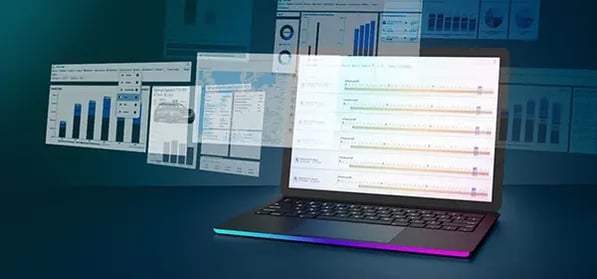Active Claim Management
IN FOCUS
Active Claim Management
Contract deviations threaten financial stability. 4 steps to the solution and what digitalization has to offer!

- Resources
- Publications
- Active Claim Management
INTRO
Why at all?
Contract essentials fail to materialize, leading to dramatic collapse in profits
At no time in the last 30 years have the deviations from the original contracts and the underlying assumptions been as extreme and extensive as they are now.
Since Corona and the semiconductor crisis, the agreed quantities are no longer being achieved by a long way. Short-term delivery schedules have lost all reliability. Prices for raw materials and purchased parts are going through the roof. The whole disaster is only completed by the exploding energy prices.
The result: the cost increases in almost all positions lead to a dramatic collapse in project profitability.
While the OEMs continue to generate profits due to clever product portfolio management, the automotive suppliers are experiencing a massive drop in earnings, which is even threatening the very existence of some of them.

"Active claim management used to make the difference between more or less profit. Now it's an existential question for many suppliers."
Erik Reiter
25 years Automotive Supplier-Management (Sales -> CEO); Sales Consultant for Strategy and Processes; Co-Founder Digital Automotive
Active claim management must be systematized at automotive suppliers, as it requires a solution for the present and the future
The solution for suppliers is active claim management, which systematizes the entire process from the drafting of the contract and the identification of deviations to follow-up and receipt of payment.
The above-described profit- and existence-threatening deviations from the original contract assumptions are now demanding action from automotive suppliers. The multitude of projects and different contract deviations makes a digital approach inevitable.
Looking into the future will not make the problem any smaller. It will not only be crises outside the automotive industry that will contribute to this, with their impact on prices, supply and volumes. There are also various uncertainties within the industry. To pick just one important example, the unpredictability of the proportion of combustion engines to electric motors will lead to many (re)negotiations between customers and suppliers.
The better and more systematically suppliers prepare for this, the better they will master the next negotiations. How the claim process can be handled for the current situation is shown in steps 2-4. How it should run more conflict-free in the future is described in step 1:
STEP 1
Create a Contractual Basis
Not the deviation from the planning, but the deviation from the contract is decisive
Almost all automotive suppliers track the deviations from their last multi-year planning (business or budget planning) via so-called plan/actual comparisons in a very detailed approach. Interestingly, this is not done (or only in a few cases) against the contracts that the suppliers have entered into with their customers. However, these are the crucial basis for price increases or direct reimbursements that can be claimed against customers.
Even if the contracts were not perfectly negotiated in the past, the cost break down (CBD) alone provides valuable starting points for (re)negotiations.
Contract management for new projects
Ideally, contracts should be drawn up in such a way that the most important parameters relevant to success are set out in them. And, in the event of deviations, appropriate compensation is made. This applies in particular to quantities, raw materials, purchased parts (especially for mandated material), but also to wages and energy, insofar as these are relevant for the respective product.
Anyone who now says that "you can't get price adjustment clauses through to your customer“ will see that the recent developments changed the mindset of purchasing. As reliability of supply has become more important to customers, there has been an increased willingness to enter into contracts that also take into account the needs of the supplier side. To ensure that the customer does not lose out, it has proven effective to stipulate compensation in both directions in the event of deviations from the contract.
All contract bases in one database - not decentralized in Excel files
The agreed parameters should be systematically stored in a database. Decentralized storage in Excel files or filing of nomination letters in paper form in the archive is neither up to date, nor does it make a comprehensive evaluation of deviations possible. This is the basic prerequisite for the following step:
STEP 2
Detect Potential Claims in an Automated and Holistic Manner
Continuously compare contract data and actual values
Anyone who stores their contract data in a database has created the prerequisite for automatically comparing it with the actual values. Digitized to perfection, this results in an alarm system that not only detects deviations, but also evaluates them against the volumes, thus giving the potential claims a value.
This process is not a once-a-year action or, even worse, an event triggered by a surprising P&L result, but a continuous process in which the contract deviations are permanently monitored and made transparent.
The most important claim types can be calculated automatically
There are a large number of different claim types and categories. The most significant claim types and their impact on project profitability can be calculated in a fully automated way. These are:
- Volumes
- Exchange rates (fx)
- Materials
Claim Potential overviews for all customers
The individual claims can be summarized and clearly displayed in a digital system for the respective customers.
Before you start the claim process with your customers, it makes sense to get an overview of how many and in what amount claims exist. This for 2 reasons:
1. The total amount should provide an indication of the escalation level on the customer and supplier side and the steps to be taken.
2. Potential counterclaims of the customer should be known before asserting one's own claim in order to prevent possible overcompensation by the counterclaim.
STEP 3
Start Claims and Track Until Payment Is Received
Start claims - but do it right
If you are aware of the total claim volume to your customer and have also considered the framework conditions, you can start the claim process. The most important framework conditions include:
- Claim losses incurred to date and expected in the future
- Knowledge of potential counterclaims
- Pending contract awards that may become claim negotiating material
The totality of the above points is displayed automatically in a professional sales management system. This transparency also leads to a decisive negotiation aspect: if everyone in the company has the same level of knowledge, closed ranks are created, which are the basic prerequisite for successful claim management.
Staying on track and transparency to the milestones
Probably the most important claim tip is to persist. This is achieved by providing comprehensive transparency for all open claims, which are regularly presented to management.
Presenting each claim with the process step it has reached (status) creates the desired overall transparency as to when which payment can be expected. If a claim has been open for a long time or the process has stalled at some point, this serves as an escalation indicator.
The necessary reports should also be generated automatically here.
Negotiate claims until a solution is found
Negotiating openly and with all possible options is the way to a solution. The classic solution options are:
- Direct reimbursement
- Price increase (waiver of reductions)
- New business
- Rejection of a customer claim
Do not forget the invoice
It sounds banal, but even the last step needs to be tracked until the money is in the account. Many suppliers forget to settle accounts due to non-transparent processes and files scattered over hundreds of Excel lists. For those who cannot imagine this, it is recommended to take a close look in their company. A well-digitized system monitors even this last step.
STEP 4
Measure the Performance
Present claim results
Transparency about completed claims is an important basis for motivation. In order to make claiming part of the corporate culture, the performance achieved must be presented and rewarded. Healthy internal competition as to who and which team achieves the best claim results makes a significant contribution to making the claiming process a standard in the organization.
Reports are no longer prepared today, but are generated automatically
Today, the reports for performance measurement are generated completely automatically as a "by-product" of digital processes.
And not only that: the claim result is also displayed in real time. That is, the moment a claim is closed, it is visible. And if incoming payments are in the future, the cash flows are displayed accordingly.
Realizing the benefits of digitization
Digitize the Entire Process
Consistency is the key to success
The digitally mapped claim process has many advantages that mean relevant incoming payments for the supplier:
- the contract bases are available at any time at the push of a button
- the automated recognition of claim potentials
- focused processing
- performance measurement, which motivates to do more and makes claim management part of the corporate culture
The consistency in an overall system is an enormous advantage. Automated transfer of data from one step to the next and consistent reporting are the prerequisites for successful claim management.
Even more benefits with a total solution that maps the entire sales management process
Input data for the automated calculation of claim potentials, be it contract agreements from acquisition or volume information for variance control from booked business, can be transferred directly from other modules without having to enter things twice.
Claim negotiation results also belong here tracked until payment is received. For direct reimbursements, this is still relatively straightforward. For parts price allocations, it is important to ensure that the price adjustments negotiated with the claim are actually processed with the next purchase order. An integrated price management system processes all influences on the price and thus naturally also allocations resulting from claims.
Only a standard industry solution for automotive suppliers can meet the requirements
Implementing the very specific claim management requirements of automotive suppliers requires real expert knowledge. If you want to act professionally here, you need a solution that has been developed by industry insiders. When the bundled knowledge of a large number of automotive suppliers is combined in one software solution, the result is something valuable for all users.
The industry standard that has implemented the described requirements and the resulting benefits is Digital Automotive. The result for the automotive supplier: Active claim management that ensures financial stability.
CONCLUSION
- Active claim management for automotive suppliers is a complex and multi-layered process that can be implemented completely digitally today.
- The results of the right digitization are:
- Consistency in one system
- Process transparency and guided stringency from the contract basis to the settlement of the deviation
- Fully automated recognition of claim potentials
- Automatically generated and management-ready reports
- Successful implementation
- Use of existing data from other modules
- All the aspects and requirements mentioned have been successfully implemented in the leading industry standard Digital Automotive by automotive suppliers for automotive suppliers.
Experience the Next RFQs and SOPs Powered by Digital Automotive?
In over 25 years of automotive supplier sales management, we have learned the benefits of digitization. Discover an improved process experience with Digital Automotive. We are happy to share our expert knowledge with you.


